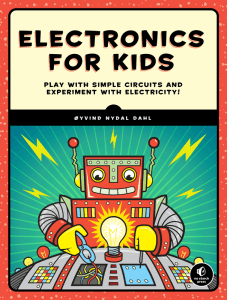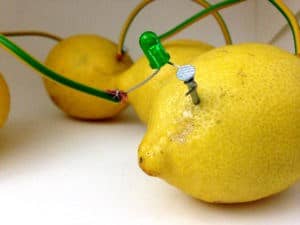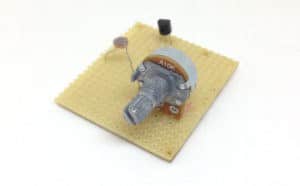 Electronics For Kids is the ultimate book for kids that want to learn how to build cool things with electronics.
Electronics For Kids is the ultimate book for kids that want to learn how to build cool things with electronics.
I wrote it as the book I would have loved to have when growing up.
It’s suitable for all “kids” that are interested in electronics, even if you’re 8 or 100 years old.
The book is very hands-on, and you’ll get to build projects like a motor, a lemon-powered LED light, an electronic coin-tosser, a really cool LED reaction game, and much more.
It has been praised in several magazines such as The MagPi magazine (issue #50), the Wall Street Journal and Geekdad.
Electronics For Kids is available from:
- Amazon
- Barnes and Noble
- No Starch Press (Use the coupon code E4KBUILDER for a 35% discount)
Electronics For Kids component kit
Jameco has created a kit for the book. I haven’t tried it myself. But Jameco has many years of experience creating kits, so I’m sure they’ve done a great job.

10 Simple Steps to Learn Electronics
Electronics is easy when you know what to focus on and what to ignore. Learn what "the basics" really is and how to learn it fast.
Get the component kit for Electronics For Kids here: https://goo.gl/oEDBHn
What’s Inside The Electronics For Kids book?
Electronics For Kids is divided into three parts:
Part 1: Playing with Electricity
This is the foundation for the rest of the book. It’s all about fundamental knowledge and how electricity actually works.
- Chapter 1: What Is Electricity? introduces the science behind electricity and describes the basic requirements for
a circuit to turn something on. - Chapter 2: Making Things Move with Electricity and Magnets shows you how you can move objects with
electricity. In this chapter, you’ll build a motor from scratch. - Chapter 3: How to Generate Electricity describes how batteries and power plugs in the wall provide electricity. Of course, you’ll build your own electricity sources, too!

Part 2: Building Circuits
This is where you’ll really get your hands dirty. You’ll meet some of the most important components in electronics, and you’ll learn how to build both permanent and temporary circuits.
- In Chapter 4: Creating Light with LEDs, you’ll build circuits on a breadboard for the first time to create a
prototype, which is just a temporary circuit. You’ll learn about resistors, light-emitting diodes (LEDs), and how to use those parts together. - Chapter 5: Blinking a Light for the First Time shows how two new components, capacitors and relays, work. You’ll even combine these with an LED to create a circuit that blinks a light.
- Chapter 6: Let’s Solder! teaches you how to solder. With soldering, you can transform a circuit from a prototype to
a proper device that will last for years to come. - Chapter 7: Controlling Things with Electricity introduces the transistor, a component that lets a circuit
control other circuits. You’ll learn how transistors work and how to use them to build a touch sensor and a simple
alarm clock. - In Chapter 8: Building a Musical Instrument, you’ll learn what an integrated circuit is and how circuits can make sound. You’ll combine this knowledge to build a musical instrument.

Part 3: Digital Electronics
In this part you’ll learn digital electronics, which almost all modern technology is based upon.
- In Chapter 9: How Circuits Understand Ones and Zeros, you’ll learn about 1s and 0s, bits and bytes, and
how to use them to communicate. - Chapter 10: Circuits That Make Choices teaches you how to build smart circuits that use logic to make decisions. You’ll build a secret code checker and learn how you can combine it with your intruder alarm.
- Chapter 11: Circuits That Remember Information shows how you can use logic gates to create circuits that remember information in a way similar to a computer. Then, you’ll use this to create an electronic coin tosser.
- Chapter 12: Let’s Make a Game! is dedicated to one large project. You’ll get to show off your new skills by combining all the knowledge from the book to make a reaction speed game.
Finally, you’ll find a Handy Resources appendix at the back of the book, which includes cheat sheets for figuring out component values, doing some essential electronics calculations, and so on.
The Electronics For Kids book is available from:
- Amazon
- Barnes and Noble
- No Starch Press (Use the coupon code E4KBUILDER for a 35% discount)
More Learn Electronics Tutorials

10 Simple Steps to Learn Electronics
Electronics is easy when you know what to focus on and what to ignore. Learn what "the basics" really is and how to learn it fast.

Where do you get the components to perform the experiments?
Hey Dal,
I’m talking with Jameco to put together a kit as soon as possible. But until then, you can also find a complete parts list at https://www.nostarch.com/electronicsforkids
Best,
Oyvind
Oyvind, is the parts kit available yet ?
Hmmm. Well. Jameco decided to just stop responding to my emails. So we started talking with Sparkfun instead. They were supposed to make a decision by end of January. We’re gonna give them a week or two more, but if nothing happens I will do it myself.
Thanks for checking in!
Oyvind
Finally, a kit is here: https://goo.gl/oEDBHn
It’ an unofficial kit made by Jameco on their own. But I’m sure they’ve done a good job.
I’m an electrical engineer and I’m on a television station
Your content was beautiful and good
Good luck
Thanks! I appreciate it =)
this book will help with my STEM program.
LTJG McDonald USNSCC
That’s great to hear!
Is there an electronic version of the book? ;)
Yes there is =) It’s available on kindle at Amazon or directly from No Starch: https://www.nostarch.com/electronicsforkids (Use the coupon code E4KBUILDER for a 35% discount)
Hi,
Do you happen to have a quiz or test booklet to accompany the Electronics For Kids?
Hi Monique. Unfortunately, I do not have that.
Sir please reply my question…
That I have stucked..
From bhushan..
In grounding and earthing section
Does Electronics for kids include all the topics that are in ‘Getting started with electronics’ and ‘A beginner’s guide to circuits’?
Do I need to buy these two books if I get Electronics for Kids
Electronics for Kids is the most complete book and I recommend doing that first. If you need more practice building circuits on a breadboard you can get ‘A beginner’s guide to circuits’ too.
Dear sir, Some months ago, You cleared some of my doubts via email about ‘Electronics for Kids’ and ‘Getting started with electronics books’.
People may have the same questions that I had about your books. So just to spread the information to the public, I am posting some information about our conversation so that people won’t have any confusion about buying your books as I had.
Question : Most of the topics in your books ‘Electronics for Kids’ and ‘Getting Started With Electronics’ seems same to me. So is there any difference between these two books ?,
Are the topics that are similar in these two books explained in the same way or the second book ‘Getting Started With Electronics’ has more details about the topics ?
Answer :
Electronics for kids is much more comprehensive than Getting Started With Electronics, and that’s the one I recommend for those who want to really learn. Getting Started With Electronics is shorter and easier, but not so comprehensive.
Question : I think some of the topics are missing in electronics for kids e.g.
* “What goes in, must come out”
* “What goes up, must come down”
Fridge alarm circuit, metronome circuit.
Do you still think that ‘Electronics for Kids’ includes all the topics that ‘Getting started with electronics’ has? Should I consider buying ‘Getting Started With Electronics’ If I bought ‘Electronics for Kids’ ?
Answer :
The topics “What goes in, must come out” and “What goes up, must come down” are about how current and voltage works and it’s also included in Electronics For Kids. They don’t include the exact same projects, but many projects are similar.
If you get Electronics For Kids, you don’t need Getting Started With Electronics